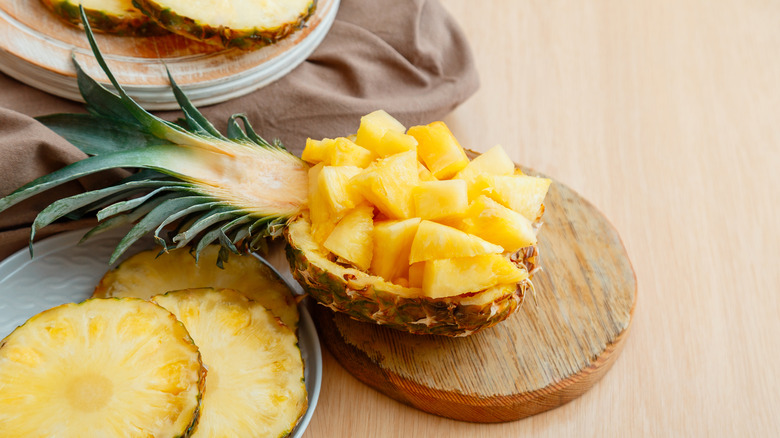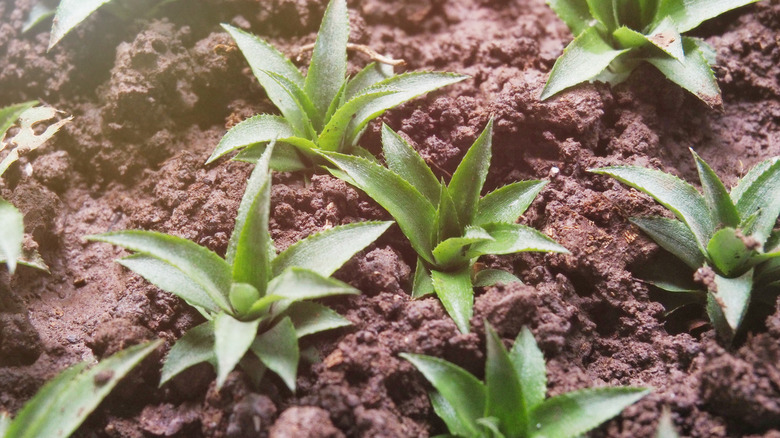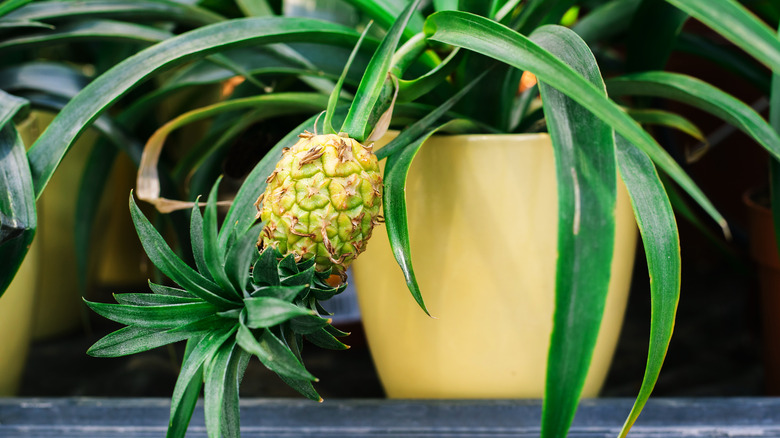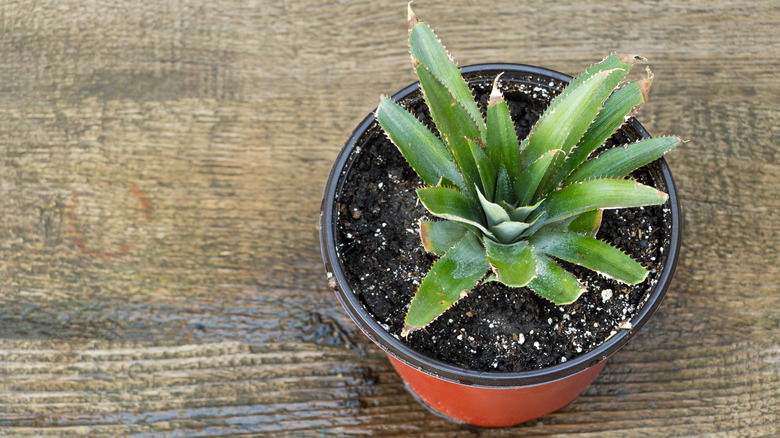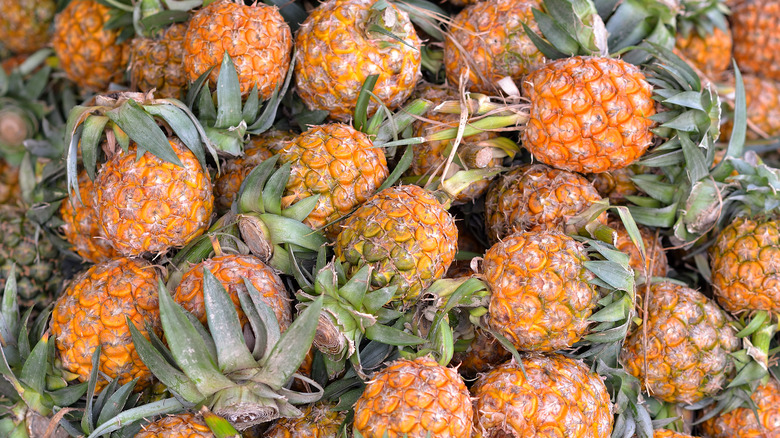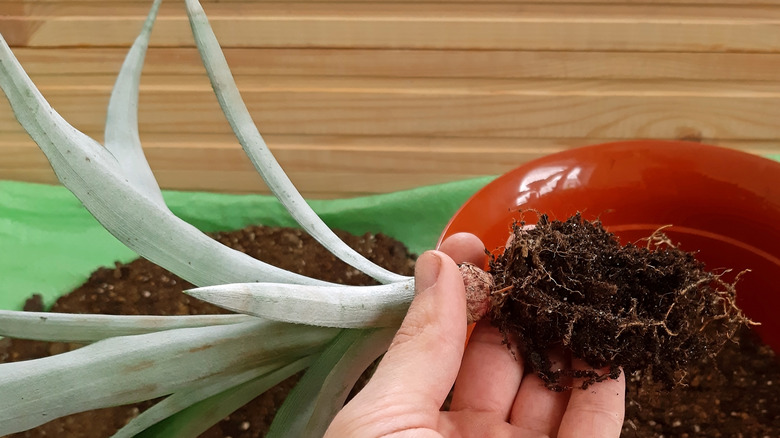How To Grow Pineapples
Pineapples, also known as Ananas comosus, are one of the sweetest fruits and have lots of nutritional value, including vitamin C, vitamin A, calcium, and tons of antioxidants, according to Healthline. Pineapples are tropical fruits that are oval-shaped and yellow-brown in color with long, green crowns. They can grow to be 3 to 6 inches tall, according to Gardening Solutions. This sweet fruit takes anywhere from a year to a year and a half to grow in your garden, depending on the climate and care.
Pineapples are native to tropical areas of America, and they were introduced to other areas over time, according to Britannica. This delicious fruit is easy to incorporate into many cuisines, making it a popular favorite for cooking. Pineapple is often a featured ingredient in meat, vegetable, fish, and rice recipes. Because of their popularity in cuisine, the practice of growing pineapples spread across the world relatively quickly. Brazil, Costa Rica, India, Thailand, and China are some of the major contributors who grow and distribute pineapples, but they're also easy to grow yourself.
How to use pineapples in your garden
Pineapples are a great addition to any garden and can be used as barriers or even to add some visual interest to your space. Because of their bright flowers and spiky leaves, pineapples make great accent pieces in a garden. For example, you can plant a few clumps under a fruit tree to spruce up the space and add some texture, according to Tropical Permaculture. You can even try planting them in a single row along a driveway or pathway to create a clean edge. This works particularly well in the front of your home, and it allows you to admire your plants the moment you arrive home.
There are also some practical ways that planting pineapples can benefit your garden. Pineapples can be used as borders and planted in rows or small sections to prevent animals such as possums from ruining your garden. Or try planting your pineapples in areas where you notice erosion. Their roots and foliage will help prevent too much water movement. You can also create a nursery bed of pineapples that will help them grow evenly, especially if you have a few plants that aren't growing. This will also make it easier for you to water and fertilize your young plants all at once.
How to grow pineapples
Growing pineapples is an easy process, but it can take some time until you have mature fruit. Pineapples are most commonly grown through propagation, so you will need a fresh, mature pineapple to start. Some other tools you will need include a flower pot, cactus potting soil, and a spray bottle with water, per Today's Homeowner.
The first step is to cut the crown off your fresh pineapple. Remove any leftover fruit flesh as it will rot. Then cut off small slices of the stalk until you see a ring of brown specs. This is where the new roots will grow. Remove a few leaves to expose the bottom inch of the bare stalk and let the stalk dry for a few days before continuing.
After a few days, prepare your pot by filling it with the cactus potting soil. Place the pineapple stalk about an inch deep into the mixture. Water the soil using the spray bottle and place the pot in a sunny area. Water the plant daily to keep the soil moist. In two to three months, your pineapple should have roots. If you're unsure if your pineapple has rooted, gently pull on the crown. If it stays in the soil, the roots have formed. Once you notice new leaves growing from the center, you can repot the pineapple into a 10 to 12-inch pot with cactus soil. After a year, move your plant to a 5-gallon planter.
How to care for pineapples
Caring for your pineapples is extremely easy, and it won't take much time out of your day. The primary care that pineapples require is frequent watering. You want to ensure that the soil is always moist. When you notice that the top of the soil is looking dry, it is time to water the plant, according to Gardeners' World. Since the weather continuously changes throughout the year, you may need to adjust how you care for your pineapples. For example, if your pineapples are still in the growing stage during winter, keep the soil slightly moist at all times.
Pruning is another big part of pineapple care, whether your pineapples are growing quickly or not. If you notice any dry leaves on your plant, you can simply trim them so that they can grow healthier. Regularly rotating the plant will also help the leaves grow evenly, especially if it is in an area with minimal sunlight.
Pineapple varieties
There are over 25 different species of pineapples, all native to the tropical and subtropical areas of Central and South America, Australia, India, South Africa, and the Caribbean. These fruits are also great to grow in your garden or as a houseplant. They can be found in dwarf varieties weighing only a few pounds or in larger varieties, with some growing up to 22 pounds, according to Home Stratosphere. They're divided into four main categories, Abacaxi, Queen, Red Spanish, and Smooth Cayenne, with each category having several varieties of pineapples.
- Abacaxi Pineapple: This sweet variety of pineapples is one of the most fragile pineapples. It can't be used commercially because it doesn't ship well due to its softness.
- Queen Pineapple: These pineapples are smaller than most others and can tolerate diseases and colder temperatures better, even though they are typically grown in warm climates such as Australia and South Africa.
- Red Spanish Pineapples: Native to the Caribbean, these pineapples are commonly transported worldwide since they're not a fragile variety.
- Smooth Cayenne Pineapples: Smooth Cayennes are grown in Hawai'i and make up most of the canned pineapples you see in the supermarkets. In fact, they make up 90% of the canned fruit in the world.
Are pineapples toxic?
Pineapples aren't toxic to animals such as cats and dogs, but that doesn't mean they should be eating huge amounts of this fruit. Since pineapples contain a lot of sugar, dogs won't be able to digest the fruit very well, according to the American Kennel Club. It's acceptable to feed your furry friend small amounts of this fruit, although it may be better to just give them the hard outer skin of the pineapple to chew on. Ensure that if you give your dogs some pineapple, it's always fresh and never from a can since canned pineapple has more sugar than fresh pineapple.
On the other hand, cats may get an upset stomach or experience an allergic reaction if they eat pineapple, according to The Whole Portion. Cats are solely carnivores, and they have specific digestive systems that aren't equipped for fruit, such as pineapple. Like dogs, cats can chew on the outer skin of the pineapple, though, and often they will because of their instincts to chew plants. Even if your cat ate some pineapple, they wouldn't be able to taste the sweetness because of their specialized taste buds.
How to repot a pineapples
If your pineapples are planted directly in the ground, they typically don't need to be repotted as they grow to their adult size. However, if they're being grown indoors or in smaller containers, they may need to be repotted, per Gardeners' World. Thankfully, repotting your pineapples is quick and easy and only takes a few steps.
First, choose a pot slightly larger than the pot your pineapples are currently growing in. Fill the new pot with cactus potting soil to prepare for repotting. Then prune any dead or dying leaves from your pineapples before gently scooping out the soil around your plant and wiggling it out of the original pot. Take care not to damage any of the roots or leaves. Shake out a bit of soil from the roots, and then place your plant into the new pot. Fill any open areas with more cactus potting soil and water until the soil is moist. Continue watering your pineapple daily as it adjusts to its new pot.
